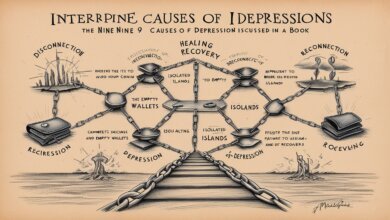
Understanding Borderline Personality Disorder (BPD): Symptoms and Diagnosis
Table of Contents
Understanding Borderline Personality Disorder, or BPD, is quite a complex and, at the same time, one of the most misunderstood mental health conditions. Characterized by pervasive instability in moods, behaviour, self-image, and functioning, BPD can result in impulsive actions and problems in relationships. This paper tries to delve into the details of core symptoms for the purpose of spotting them and goes deeper into the processes of diagnosis, underlining the need for an exact identification for effective treatment to be possible.
Recognizing Borderline Personality Disorder Symptoms
BPD is expressed in deficient emotional regulation, maladaptive behavior, and impairment of interpersonal relatedness. It is important to know the symptoms of the disorder so that one can easily identify and implement change with the right kind of help.
- Affective Instability One among the hallmark symptoms of BPD is affective instability. Persons with BPD have very strong emotions that change in a rapid manner sometimes without stimulus. This might include feelings of truly awful depression, anxiety, or irritability, which last from a few hours up to a few days. The emotional responses are inappropriate to the circumstances, making it hard to deal with everyday life issues.
Characteristics of Affective Instability:
Mood Swings: Fluctuation from joy to sadness, anger, or anxiety in a blink of a moment.
Intense Feelings: Overreaction to small problems or even mild provocations.
Feelings of Emptiness: A feeling of emptiness from within that doesn’t allow one to be at peace and self-content.
2. Impulsive Behaviors
Impulsivity is another of the central symptoms of BPD, which most of the time manifests in risky self-damaging behaviors. This can be due to substance abuse, reckless driving, binge eating, or unsafe sexual practices. In most cases, impulsive actions are usually a reaction to emotional distress or a way of trying to deal with feelings of emptiness.
Key Features of Impulsive Behaviours:
Self-harm : It consists of self injurious behaviours like cutting or burning.
suicidal ideation or attempts, mostly as an escape measure from the emotional agony;
Addictive Behaviors: Abuse of substance or other forms of addiction.
- Relationship Problems
Most of the time, the person with BPD is unable to maintain stable and healthy relations. The relationship can be passionate and erratic, moving from idealization to devaluation. There may be a rapid swing from extreme closeness and affection to anger and detachment—this phenomenon is called “splitting.”
Key Features of Relationship Problems:
Fear of Abandonment: Such an excessive fear of abandonment, that a person resorts to frantic activity to try and prevent abandonment, whether real or imagined.
Unstable Relationships: Intense but stormy relationships, marked by frequent break-ups and reconciliations.
Attachment Problems: Difficulty establishing secure and trusting relationships with others.
- Distorted Self-Image
People with BPD often exhibit very unstable or distorted images of themselves, thus affecting their goals, values, and relationships. They may perhaps experience the symptoms as having no sense of self or what they would want to do with their lives. Identity instability makes one change jobs frequently, friends change, and life plans altered quite often.
Distorted Self-Image: Key Features
Identity Disturbance: Markedly and persistently unstable self-image or sense of self.
Goal and Value Changes: Sudden career wanting, sexual interest, values, or friends.
Feelings of Estrangement: Feeling detached from self or observing self from outside the body.
- Cognitive and Perceptual Disturbances
Cognitive and perceptual disturbances can also be present with BPD. Some individuals experiencing transient, stress-related paranoid thoughts or severe dissociative symptoms may feel utterly disconnected from reality.
Key Features of Cognitive and Perceptual Disturbances:
Paranoia: Suspiciousness or paranoid ideation, mainly in the presence of stress.
Dissociation: Moments of unreal feelings, detachment from self, or feeling detached from surroundings.
Distorted Perceptions of Others: Misinterpreting others’ motivations or actions as hostile or rejecting.
- Chronic Feelings of Emptiness
The most common symptom that appears in BPD is chronic feelings of emptiness. This can take the form of a hollow, void feeling and leads to a constant search for ‘something’ to alleviate this sense of emptiness through impulsive, potentially harmful behaviors.
Key Features of Chronic Feelings of Emptiness
Inner Void: Characterized by a pervasive feeling of inner emptiness or nothingness.
Lack of Fulfilment: No satisfaction or other positive feelings are derived from participation in activities or relationships.
Desperate Attempts to Fill the Emptiness: Engaging in impulsive behaviours as a way to overcome feelings of emptiness.
Diagnostic Process for Borderline Personality Disorder
The diagnosis of BPD can only be made after a comprehensive mental health assessment by a professional. Clinical interviews, questionnaires, and sometimes empirical data supplied by family members or close friends may form the diagnostic process. Understanding the diagnostic criteria and process is essential in spotting the disorder and seeking proper treatment.
- Clinical Interviews
However, a comprehensive clinical interview is still considered the gold standard in assessing BPD. The health professional will ask for the patient’s symptoms, past medical history, and family history. Accompanying this must be an assessment of how much impairment in daily life and relationships the symptoms cause.
Major Features of Clinical Interviews:
Assessment of Frequency, Duration, and Intensity of Symptoms by Careful Questioning:.
Medical and Family History: Obtaining information about any history of mental illnesses in the patient and his or her family
Impact on Functioning: Assessing the impact of symptoms on the patient’s daily functioning
- Diagnostic Criteria
BPD is therefore diagnosed based on the criteria outlined in the DSM-5. According to DSM-5, any individual has to at least show five of the following symptoms for them to be diagnosed with BPD:
Frantic efforts to avoid real or imagined abandonment.
A pattern of unstable and intensive interpersonal relationships characterized by altering between extremes of idealization to devaluation.
Identity disturbance: markedly and persistently unstable self-image or sense of self.
Impulsivity in at least two areas that are potentially self-damaging (e.g., spending, sex, substance abuse, reckless driving, binge eating).
Recurrent suicidal behavior, gestures, or threats, or self-mutilating behavior.
Affective instability due to a marked reactivity of mood (e.g., intense episodic dysphoria, irritability, or anxiety usually lasting a few hours and only rarely more than a few days).
Chronic feelings of emptiness.
Inappropriate, intense anger or lack of control of anger as manifested by at least one of the following: frequent displays of temper, constant anger, recurrent physical fights.
Transient, stress-related paranoid ideation or severe dissociative symptoms.
- Questionnaires and Self-Report Measures
Supplemental or alternative diagnostic tools that a clinician may employ to evaluate patients are standardized questionnaires and self-report measures. The tools provide additional details about the individual’s symptoms, thus supplementing or resulting in a more accurate diagnosis.
Key Features of Questionnaires and Self-Report Measures:
Standardised Tools: Using validated instruments like the Borderline Symptom List or the McLean Screening Instrument for BPD.
Self-report: Taking self-report of symptoms from individuals based on personal experiences
Cross-Validation: Cross-validation of what the questionnaires elicit with the result of the clinical interview.
- Collateral Information
The collateral information from family, friends, or significant others can put perspective to the symptoms and their affect.
It confirms the diagnosis and helps in understanding the patient’s behavior across situations.
Elements of Collateral Information:
Input from the Family: According to family members, one is used to the person’s behavior and background history.
Friend and Partner Reports: Information is gathered from close friends or partners about the individual’s symptoms and relationships.
Contextual Understanding: An understanding of how symptoms are expressed in different contexts, for example, at home, work, while out socially.
Accuracy in Diagnosis is Important
Accurate diagnosis of BPD is crucial for a number of reasons. Proper diagnosis ensures proper treatment and care. Without an accurate diagnosis, it is not possible to understand the root causes attributing to an individual’s symptoms, and the potential for misdiagnosis and inappropriate remedies is significantly enhanced.
- Targeted Treatment
The success of the patient’s diagnosis would be the ground upon which a course of targeted treatment could be developed, which is aimed at issues or symptoms unique to BPD. It may also include psychotherapy, medication, and lifestyle changes.
Brief Description of Essential Elements of Targeted Treatment—
Psychotherapy: This shall consist of evidence-based therapy adapted to BPD symptoms, such as DBT or CBT.
Medication: Pharmacological interventions shall be established to treat co-occurring disorders or other symptoms; examples include mood stabilizers or antidepressants.
Lifestyle Changes: Ensuring healthy habits, stress management techniques, and social support networks. - Understanding and Support
A clear diagnosis helps the individual and his family understand the nature of BPD—a reduction in stigma and an increase in empathy. It gives the individual and his family a framework to understand the symptoms and to formulate strategies for their proper management.
Key Aspects of Understanding and Support:
Education: Informing the individual and his relatives about BPD.
Stigma Reduction: Dispelling myths and promoting empathic approach to mental illness.
Empowerment: AssistingPatients with BPD to become more actively involved in their care.
- Prevention of Misdiagnosis
On numerous instances, BPD can be miss diagnosed as other psychic disorder like bipolar disorder, depression, or anxiety disorders. A correct diagnosis significantly contributes to dissociating BPD from the above-mentioned disorders and ensures that proper intervention is implemented correspondingly.
Prevention of Misdiagnosis –elements
Differential Diagnosis: Careful assessment of symptoms to differentiate BPD from other disorders.
Full Assessment: Assessment based on every aspect of an individual’s mental health and history.
Ongoing Evaluation: Continual assessment of symptoms and response to treatment to ensure accuracy.
Conclusion
The diagnosis of Borderline Personality Disorder represents a very complex disorder that requires underpinning knowledge about its symptoms and the diagnostic process involved. The first way to find help is becoming aware of the cardinal symptoms of emotional instability, impulsive behaviours, and relationship difficulties. Accurate diagnosis—right down to the clinical interview, diagnostic criteria, questionnaires, and collateral information—is where effective treatment begins. We need to better promote awareness and understanding about the experience of living with BPD if quality of life among this group is to be improved by navigating their issues with compassion and care.
More articles :
Sources:





One Comment